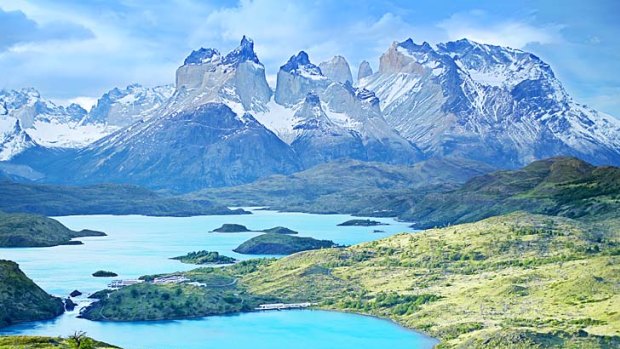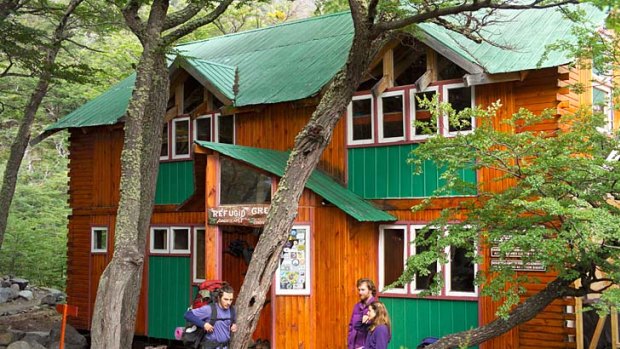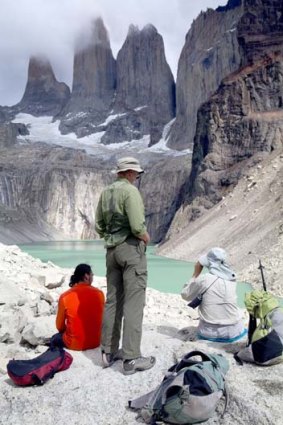
The brilliantly blue Lake Pehoe and the Cuernos? peaks.Credit: Getty Images
Andrew Bain treks into Chilean Patagonia's Torres del Paine National Park to view its glacier, lake and needle-sharp peaks.
At the foot of the Torres del Paine mountains in southern Chile, pink flamingos step through the shallows of turquoise lakes. Llama-like guanacos trot from the roadside and Andean condors swirl around the rocky mountain tops. Life seems to flourish wherever I look, and yet so much has just been destroyed here.
In the last days of 2011, fire ripped through Torres del Paine National Park. Allegedly started by a hiker burning toilet paper, the blaze scorched more than 17,000 hectares, or about 7 per cent of one of South America's most famous national parks.

Highest honours... Refugio Grey in the Torres del Paine National Park.Credit: Alamy
I arrive at Torres del Paine just days after the full reopening of hiking tracks in February. Like most visitors, I'm here to trek. If it seems a bad time to visit, it's not. The fire scarring is confronting and the land will take decades to recover - early forecasts are that 20 per cent of burnt trees will never recover - but the fire affected only about 15 kilometres of the park's main trails. Every feature that draws people to the Torres del Paine - the peaks, the glaciers, the lakes, even most of the forest - is still here and mostly unaffected.
I've come to hike the W Trek, a popular 70-kilometre route that slips in and out of the valleys that lead deep into the heart of the Torres del Paine massif.
On the morning I begin at Las Torres, there are brown clouds to the west as wind hurls ash into the sky. More impressive is the view of the massif. With its crown-of-thorns skyline, the Torres del Paine forms one of the most striking mountain outlines on Earth. Quills of rock rise sharply from almost every ridge and the mountains appear bent into shape by the notorious Patagonian winds.

Hikers admire Torres del Paine's towers from a lookout.Credit: Andrew Bain
In the distance, dominating the view from Las Torres, are the three towers - the Torres - that give the mountains their name. They are my trekking goal this first day.
The guiding line to the base of the towers is the Ascencio valley. The first view of the valley comes after about an hour of walking, as the trail crests a small pass. Behind me, the land outside the massif appears almost volcanic in origin - its colours all black and rust-red - but inside the mountains, a new world is unveiled.
Waterfalls skid down the steep slopes, hanging glaciers perch above the head of the valley and beech forest tapers into grassed slopes. Through the centre of it all runs the white line and white noise of the Rio Ascencio. It's almost impossible to stand here and not be drawn forward into the scene.
The climb to the foot of the towers is probably the steepest ascent of the entire W Trek, though it's not difficult - nowhere on this trek do you go higher than 900 metres above sea level. At the base of a massive terminal moraine, the trail turns and climbs, rising eventually to a lake pooled beneath the three Torres, which soar to two kilometres overhead.
Cloud steams off the mountain tops, even while the rest of the sky is blue, constantly changing the colours and the shadows on the rock. It's a difficult view to turn your back on, but eventually I must return through the valley to Las Torres.
Within minutes of setting out the next morning, the towers slide from view, hidden behind other peaks. But it's not so much a loss as a transition. Traversing the foot of the massif, I will trade my tower view for a position at the base of the Torres del Paine's cuernos (horns).
In the classic postcard views of the Torres del Paine, it's the cuernos' peaks that draw the eye. With their caramel-coloured cliffs tipped with black rock, they look as bent and worn as a farmer's fingers. Below them spreads a chain of lakes, each one a slightly different shade of blue. From up high, it's like looking over a very large paint chart.
Just beyond the cuernos, separating them from Paine Grande, the massif's highest peak, is the Frances valley. The middle arm of the "W" (which is named for the shape of the trek), this valley carves its way into the massif, past the crevassed foot of the Frances Glacier.
By the time I rise to a lookout above the glacier, wind is charging through the valley, blowing me about like paper. The air feels as icy as the glacier and snow has started to fall.
I continue up the valley, reaching a short, steep climb to the final lookout: a pile of rocks encircled by an amphitheatre of peaks. All around me, sharp-tipped mountains scratch at the sky, snow cartwheeling off the shoulder of each in the high winds. I lay back on a rock slab to absorb the view, surely one of the finest mountain scenes in the world - even the minor peaks here would be star attractions in almost any other mountain range.
Tonight I'll take shelter in the refuge at the foot of the cuernos, hiding from the winds that now gust like earth tremors. Although hive-busy in summer, these refuges are far from the basic dorms of mountain tradition. Refugio Los Cuernos is the simplest of the huts, with its three-tier bunks, and yet it serves three-course dinners to be enjoyed with a bottle of wine or a pisco sour.
The refurbished Refugio Grey, at trek's end, is the palace of refuges. Looking like a shearing shed from the outside, it's more like a wilderness lodge inside, with leather lounges and lightshades, wooden sunchairs and comfortable mattresses. The chef at the refuge at Las Torres once cooked on the Queen Mary, bringing dishes such as octopus soup and mashed potato flavoured with Greek yoghurt to the trekking menu.
The wind has stilled the next morning, but rain is falling. Along the shores of Lago Nordenskjold, the path is at times a river and the mountains are little more than vague silhouettes pressed into the mist. It's a suitably bleak day to walk into a fire zone.
About 30 minutes past the entrance to the Frances valley, the green land suddenly turns brown and black. Bare trees are bent and twisted with heat, as if in imitation of the mountain shapes above. It's like stepping into an apocalypse.
I will trudge through these burnt lands for the next five hours, with the trail following a chain of lakes around the foot of Paine Grande - their waters so blue, the land so black. In tiny patches of surviving beech forest, it's like waking from a bad dream, but otherwise it's unremittingly desolate.
On the shores of the most brilliantly blue lake, Lago Pehoe, is Refugio Paine Grande, where fire burned to within a couple of metres of the front door. About 100 metres away, a pile of black debris is all that remains of another building.
From the lodge, the trail funnels through a blackened gorge and into the Grey valley, where the fire began. Below me, icebergs calved from Grey Glacier drift into bays at the edge of Lago Grey. A condor traces invisible circles in the sky.
The first shoots of greenery are already beginning to reappear on the mata gris shrubs. On the burnt shores of Lago los Patos, a lone firebush is blooming, as if in defiance of its namesake destroyer. Life begins anew.
Andrew Bain travelled courtesy of Peregrine Adventures.
FAST FACTS
Getting there
LAN Airlines has a fare to Punta Arenas from Sydney for about $2525 low-season return, including tax. Fly to Santiago (about 17hr, including transit time in Auckland), then to Punta Arenas (3hr 30min). Melbourne passengers fly Qantas to Sydney to connect and back from Auckland; see lan.com. Qantas flies from Sydney and Melbourne to Santiago non-stop. Australians pay a fee of $US95 ($96.70) on arrival in Chile and Argentina.
Trekking there
Peregrine Adventures runs a nine-day Torres del Paine trek, which includes the W trek, from $4150. It also runs a 13-day Paine and Fitz Roy Adventure from $4995, which includes a three-day hike to Monte Fitz Roy on the Argentine border. Phone 1300 854 500, see peregrineadventures.com.
Sign up for the Traveller Deals newsletter
Get exclusive travel deals delivered straight to your inbox. Sign up now.